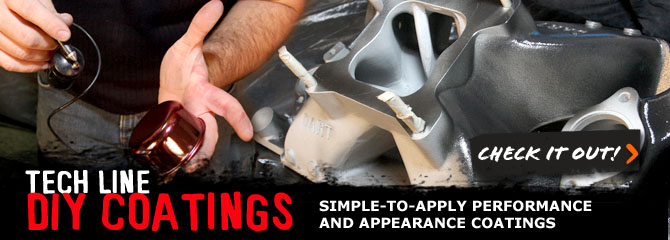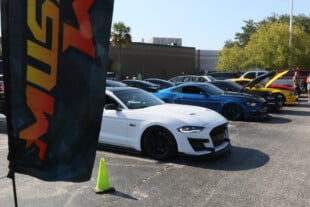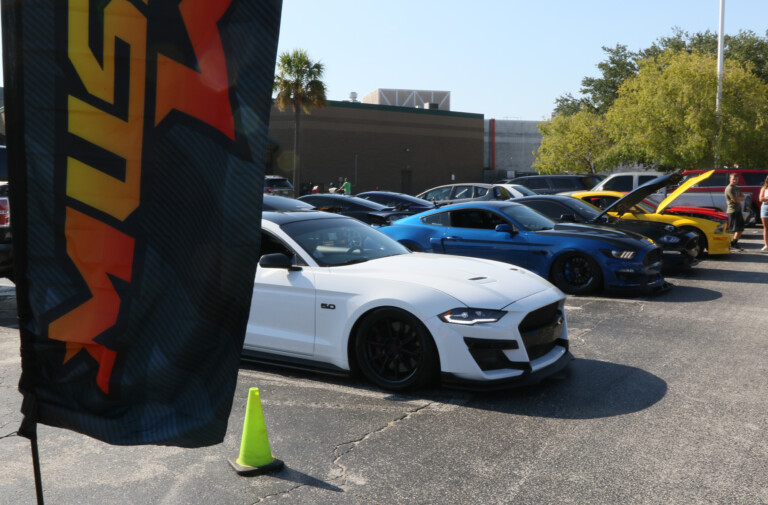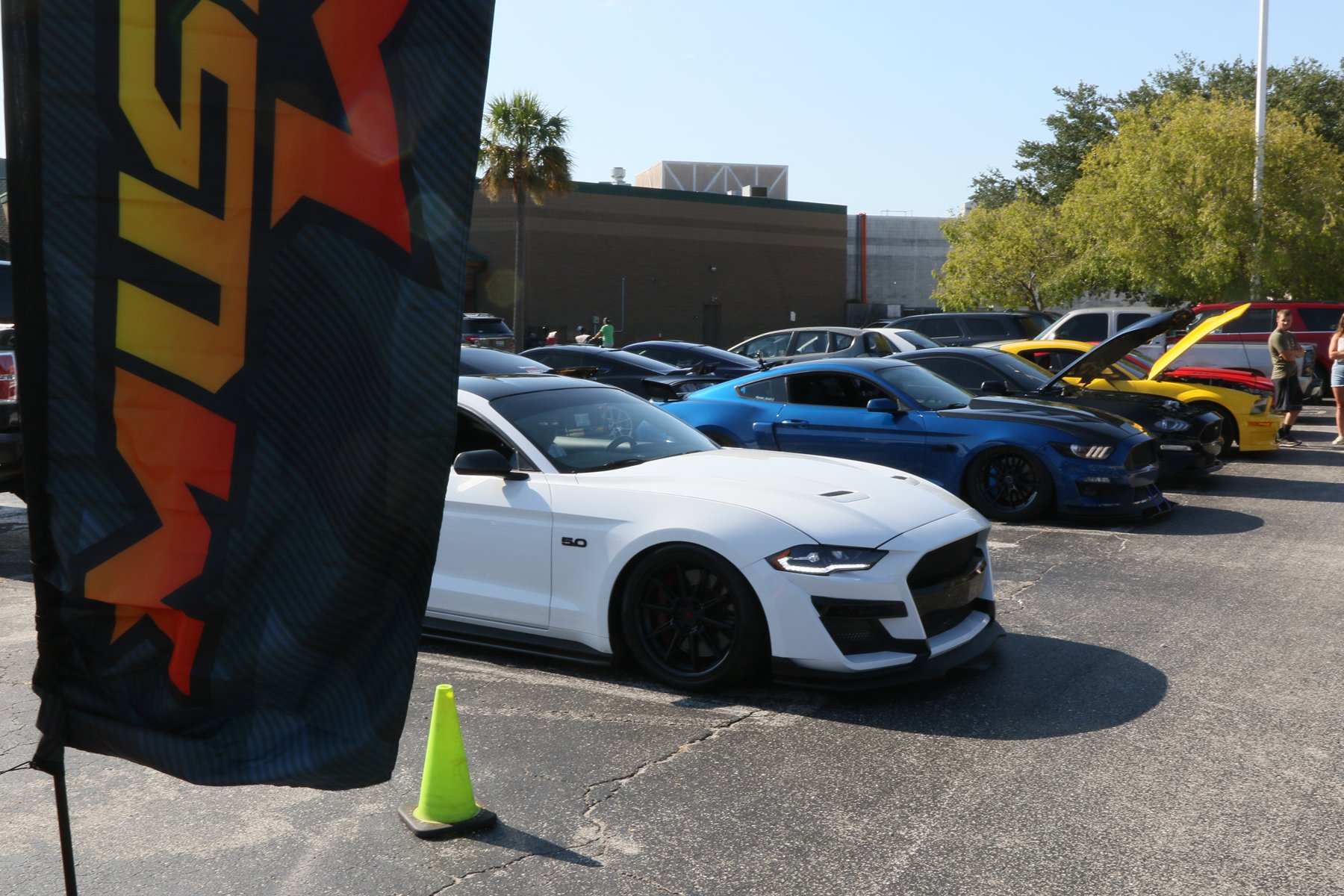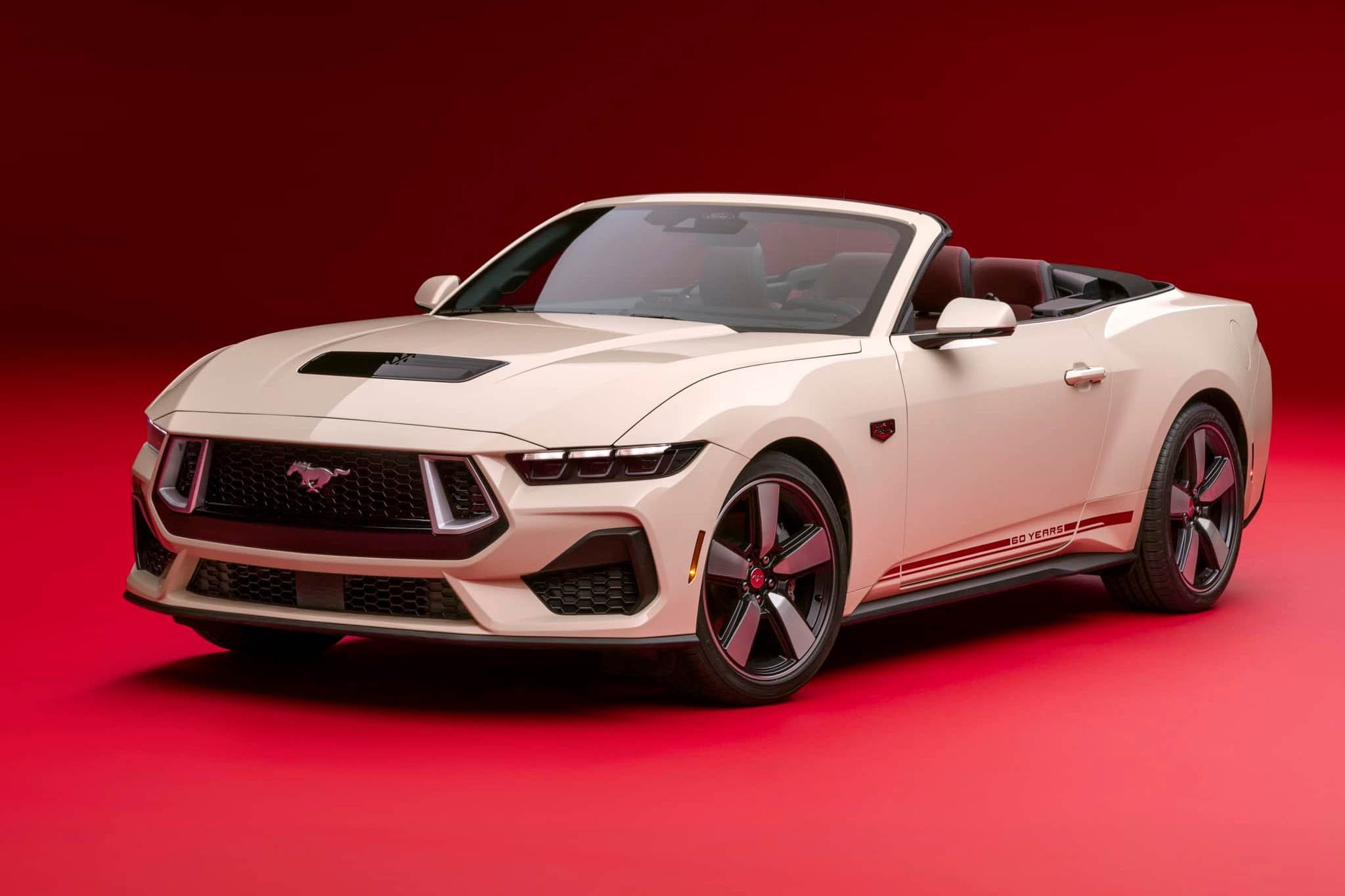Coatings do great things – anything from keeping heat out, engine items lubricated, and parts looking good. Tech Line Coatings has released a line of professional and do-it-yourself coatings that allow you to cost-effectively coat parts with little to no prior knowledge. “We have a coating for any engine part,” says Tech Line’s owner Leonard Warren. But outside the engine, there are parts like brake calipers and rear end gears that can also benefit from coatings.
There are a bunch of long words that make up the ingredients of these coatings, and one of the most important parts is picking the right coating for the job. Even knowing what metal the part is made out of is crucial to the longevity of the coating. Tech Line came by the powerTV garage to coat some parts for a few of our project cars and also educated us on how they work.
History of Tech Line
After a split in 1990 that divided the company into individual application and manufacturing concerns, Tech Line has been focused on providing coating materials to both pro and DIY users. Since 1995, shipping and sales have been handled from their Texas location, and in 2000 Tech Line opened their Corporate Offices and R & D facility in California. Today Tech Line supplies a large majority of the automotive performance coating market. Tech Line has agents in Europe, Australia, Africa and India to serve the worldwide market
Based on its expertise and reputation, Tech Line works with several major chemical companies to develop new products as well as new applications for existing products. While many coatings do not have automotive applications, any that do are incorporated into the automotive high performance line to the benefit of Tech Line’s first and favorite market.
In an effort to help as much of the market as possible, in the high performance industry, Tech Line makes a wide variety of its products available at retail. This allows the greatest number of people to benefit from the performance advantages and protective benefits of the coatings. New products are added to the line each year as technological advances are made.
Performance Coatings
It’s pretty obvious that we tailor to gearheads here, so it would only be fitting to start with the coatings that increase performance. Since Tech Line offers products for all sorts of internal and external applications, we rounded up a wide selection of parts to test:
• JE dome piston
• Engine bearings
• Dart single plane intake manifold
• Hooker headers
The first coating we started on was the oil-retaining coating called the DFL-1 Powerkote
Dry Film Lubricant
DF1-1 is a high-pressure, water based dry film lubricant with no hazardous fumes. Engine bearings have to be tough while also being soft enough to allow small particles to embed in the bearing surface instead of scratching the metal journal.
Dry film lubricants contain special pigments that reduce friction and wear by preventing surface-to-surface contact between mating parts. The naturally slick coating also has properties to retain oil on the bearing surface. Best of all, the coating does not alter the clearance of any part with its thin film (.0003″-.0005″). Warren remarked, “We have seen engines survive races for thirty minutes that had coated bearings with a failed oiling system.”
One of the most common causes of engine destruction is oil starvation to the cam and main bearings. With cranks and rods rotating at thousands of revolutions a minute, it doesn’t take much to spin a bearing if there is an oil starvation problem. A spun bearing can lead to a number of problems, most commonly seen as rod knock, or if you are really lucky, a rod out the side of your block!
The other part that we coated with DF1-1 was the skirt of our JE piston. The skirts of a piston have a similar interaction with the cylinder walls – though the piston rings do the sealing, a thin layer of oil is all that separates the skirt from the wall of the cylinder. This is another crucial place where oil failure can create problems. An additional concept to keep in mind is that if you are reducing friction with these coatings, that reflects in a gain of power.
Applying the lubricant is simple. Completely clean the bearing and skirts with acetone to remove any dirt or oils from your hand. Mask off the ring lands with painter’s tape. The coating is then mixed and applied evenly on the surfaces with an airbrush or detail gun. After the pieces air dry, they are ready for baking, though it isn’t time just yet as we will also be applying a high temperature reflective coating to the piston top.

We lightly sandblasted the intake manifold to make sure it was completely clean, and give the surface some “tooth” for the coating to adhere to.
To prepare for the coatings, the intake manifold, headers, piston tops and skirts were all lightly sandblasted to create a minimal amount of texture that the coatings need to adhere to.
“Most of our coatings do multiple things”, Warren commented. As an example, the thermal barrier coating that we are going to put on the intake manifold also has an oil-shedding property to keep oil from collecting on the valley side of the manifold.
Metallic Ceramic Thermal Barrier Coatings
CBC1 is Tech Line’s do-it-yourself thermal barrier that is also a water-based dry film lubricant with no hazardous fumes. Thermal barrier coatings generally consist of four layers. They are the metal substrate, metallic bond coat, thermally grown oxide, and ceramic topcoat. The metal substrate and metallic bond coat are metal layers and the thermally grown oxide and topcoat are ceramic layers. The bond coat creates a bond between the ceramic coat and substrate. The ceramic top coat is very low in conductivity while remaining stable at operating temperature.
There are some parts of an engine where you want to keep heat in and then there are some you want to keep heat out. For the piston top and Dart single plane intake manifold, we want the heat to stay away. Keeping the heat off your piston top and inside your combustion chamber will allow the piston to handle more power and promote a better burn. Detonation is a curse word in racing and by keeping the pistons cooler, less heat will be transferred to the incoming air/fuel mixture which will lead to a reduction of pre-ignition.
Additionally, the coatings can also allow heat at the surface to move evenly over the piston top, reducing hot spots. For those of you running a 13:1-plus compression ratio or any sort of power adder, Tech Line recommends using their CBX thermal barrier that creates a hard surface specifically designed for engines that run on the ragged edge. “Some racing organizations don’t allow visible coatings, and after the thermal barrier is baked on the piston top can be polished to resemble the original color of the piston,” says Warren.
The Dart intake manifold has all the exterior areas including the coolant crossover coated, but not inside the manifold. The header design brings the primary tubes closer to the intake manifold then a conventional long tubes, and the engine bay for our application is a tight fight as well. Having so much heat around the intake would make the casting absorb the heat easier if we did not use the thermal reflective coating, so now we can keep our intake charge cooler. The coating was used in the coolant crossover to keep the heat from transferring through the intake manifold and into the intake tract. Since the thermal barrier also has oil-shedding properties, the valley side of the intake will resist oil that is splashed up from the cam and lifters.
The inside of the manifold had dry film lubricant applied to create a slight textured surface in order to create boundary layer turbulence and prevent fuel drop-out. This creates a slight “tumbling” effect on the surface of the intake manifold to help promote proper air fuel atomization prior to entering the combustion chamber.

The completed intake with thermal barrier coating on the exterior, dry film inside, and black “Brillance” coating on the water neck and distributor hold down.
Keeping heat in with Cermakrome
In exhaust components we want to do the exact opposite of what the thermal barriers do; we want to keep the heat in. Cermakrome is a metallic ceramic coating that provides corrosion and heat insulation for exhaust components. Tech Line has tested the coating at 1300-degree base temperature and 1600-degree exhaust temperature as well as a 6500-hour salt spray test for corrosion.
We needed to re-coat our Hooker headers since we had to perform some modifications to them that destroyed the factory-applied coating in a few areas. After the headers were sandblasted, we were ready to apply the Cermakrome coating. Applying the coating is done in the same fashion as the oil shedding coating – a simple detail gun or airbrush works great. Once all the thermal-coated parts had dried, we needed to bake them for 300 degrees for one hour, except the Cermakrome that needs 500 degrees.
The headers could then be polished after baking to give them the traditional chrome look. The piston and bearings were small enough to put into a toaster oven, while the headers and intake required a conventional-size oven. “Since the coatings are water based, chemicals can damage the coatings until they are baked,” said Warren.
The Appearance Coatings – Brilliance
While performance coatings do their job behind the scenese, there is always the need to make parts look good too. Tech Line’s Brilliance formula is one of their “do it at home” kits that is designed to be sprayed on shiny surfaces due to its semi-transparent nature – the higher the gloss, the more the reflective it will be.
We demonstrated their red and black coatings on some engine parts as well as a wheel. We started with the red and applied them to a wheel and a pair of valve cover breathers. After that, we moved to the black that was applied to a water neck, a distributor hold down, Dart valve covers, and a Holley Powershot air cleaner. The results were stunning; as you add more layers, the shade of the color changes right in front of you. The red breathers look anodized while the black pieces show an awesome black chrome finish. These are not all the colors Tech Line offers as they cover virtually every color there is.
Application of the Brilliance coating is simple. First, start by cleaning the part with acetone. Next you will apply a layer of clear that acts as an adhesion coat that will need to sit for a few minutes before applying your first coat of color. The kit requires a little mixing to get your desired shade. There is a little wait time between coats, but once you are happy with the shade, a simple finish coat of clear is all you need and the parts will air dry. One functional aspect of the Brilliance coatings is that they are very easy to clean.
Tech Line Develops a Headlight UV coating for IMG Solutions
The bad thing about stock, plastic headlights is that they cloud up and get yellow when they get old. IMG now makes a restoration kit that restores them back to their original shape, but I was skeptical, so Brian from IMG went to work on our Camaro project, “All Air”. It is rather simple to do and can be done in a few steps. The first step is to mask off all the paint areas near the headlights. The second step uses various grits of sandpaper to clear off the oxidation and old UV coating. After that is done, a polishing compound is used with the final step being the Tech Line-developed UV coating to bring out the shine, and there is a night and day difference in how the headlights look. The kit comes with everything you need, minus a power drill, and takes about 30 minutes to do.
powerTV Projects Enhanced with Tech Line Coatings
In a day’s work we updated parts for our project vehicles in both function and fashion. Some of the coatings we talked about today (like the thermal barriers) are for shop use only, but Tech Line is constantly developing coatings that are simple to apply and even have an air-dry thermal coating in testing for home use. Just remember the next time you build an engine, virtually every part can benefit from coatings, so give them a little TLC!



